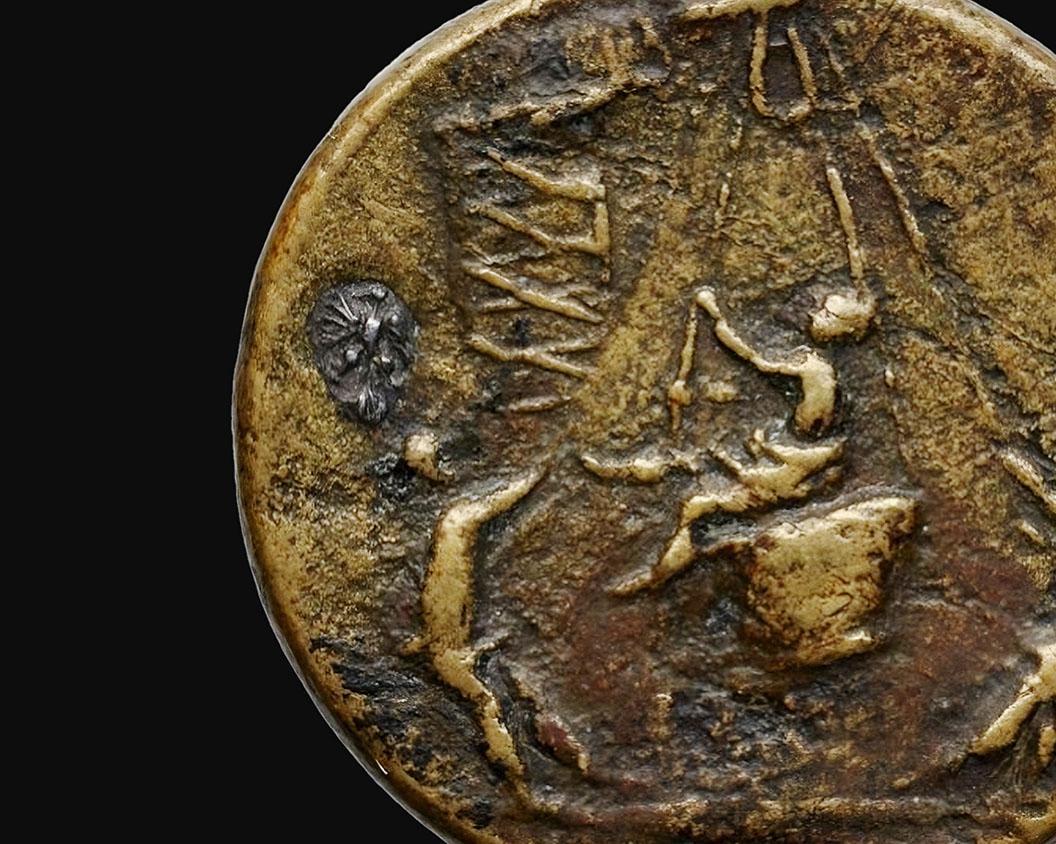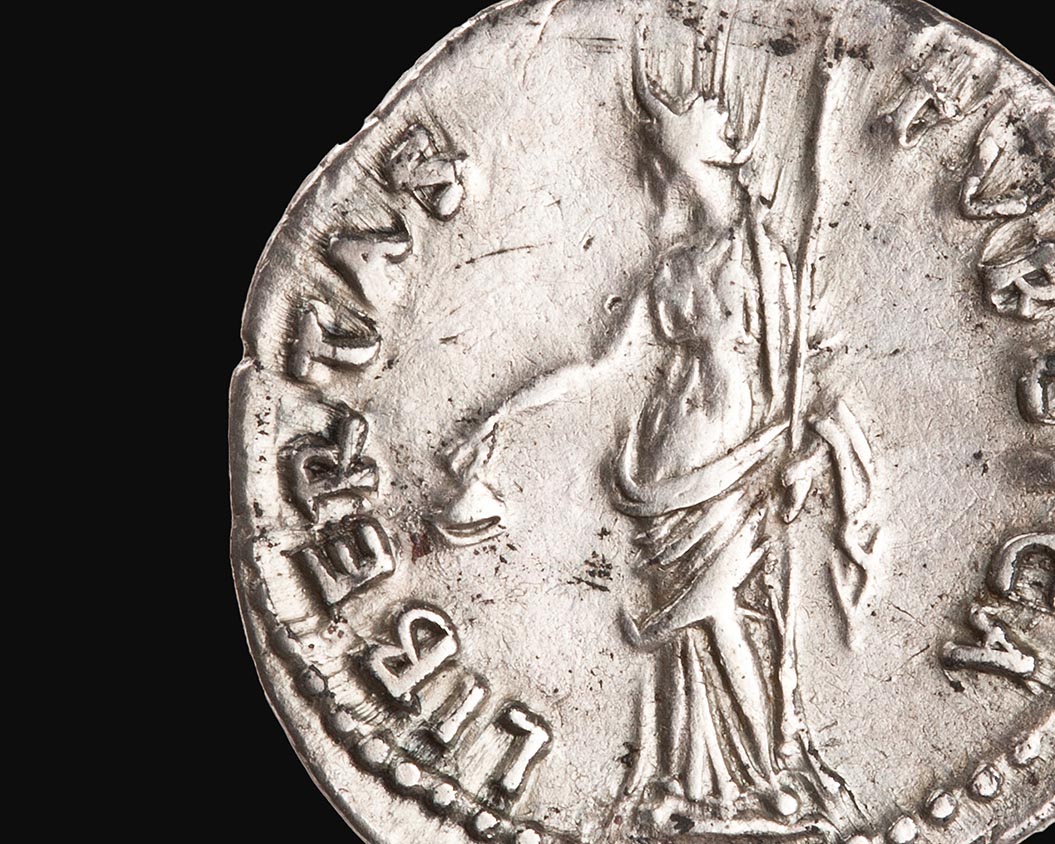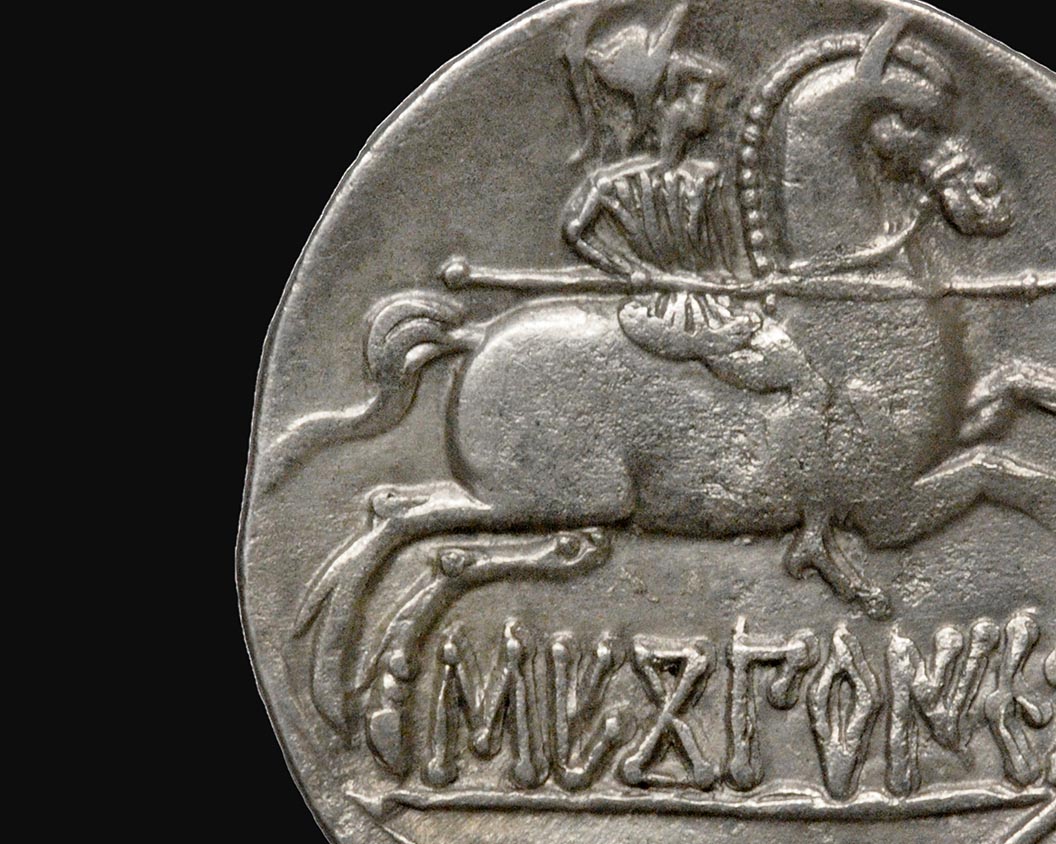The Matter of Inflation
Metallic Objects
We are used to considering money as a stamped object, whether minted or printed, where often a number displayed on the object indicates its exchange value. This has not always been the case. Throughout Europe, Asia, Africa, and the Americas, various metal objects assumed privileged roles as mediums of value and exchange based upon their weight. Metallic artifacts in the form of bars, bracelets, and other objects, allowed users to store value and avoid the need for barter. Gold, silver and bronze were mostly used.
0000.999.566
Rome. Cast monetary ingot (= aes rude in Latin), c. 500-300 BC. Bronze, 137.2 g (ANS 0000.999.566).
As in other regions of the ancient Mediterranean world, the earlier forms of money used by the Italians (including the Romans) were weighed bars of bronze, following several standards used in different regions. In the 1st century A.D. Pliny the Elder attributed to Servius Tullius, the 6th century B.C. Etruscan king of Rome, the initial decision to mark bars of bronze in order to establish an official standard, long before actual coins were minted. Modern scholars do not give much credence to Pliny’s account in general, but he was essentially correct in stating that ingots and bars preceded coins. After the Romans started to mint bronze coins, inflation took place as a result of successive weight debasements while units of accounts were kept the same.
1937.179.19477
China. Prototype knife, dao, c. 800-400 BC. Bronze, 69.24 g (ANS1937.179.19477, gift of Frances Reilly).
Chinese tradition, expressed by the 1st century B.C. historian Sima Qian, spoke of cowries, tortoise shells, coins, gold, spades, and knives all used as mediums of exchange for a long time prior to the unification of the country.
1991.8.6
Nigeria (British Colonial period). Manilla, c. 1900. Bronze, 86.32 g. Birmingham (ANS 1991.8.6, gift of George M. Golden).
Portuguese merchants, sailing south to the Kingdom of Benin on the western coast of Africa, first introduced manillas (Portuguese for “bracelet”) in the 1400s as a trade item that they could exchange for Benin pepper, ivory, cloth, and slaves. The manillas, made of copper, brass, and, in later years, leaded brass, became a primary form of currency among the people of present-day Nigeria and Benin and may have been valued in part as a material that could be melted down and made into elaborate works of art. In later years, the British, French, Spanish, and Dutch all began manufacturing and exporting manillas, and millions were sent to West Africa for trade. The result was inflation: in the 1400s, a slave was valued at 4 manillas, and in 1522 at 57. After decades of circulating alongside the British shilling, manillas were officially withdrawn from circulation by the British government in 1948.
0000.999.75836
Liberia (Kissi area). Five rods (“Kissi pennies”), 20th century. Iron, from 7.80 to 79.84 g (ANS 0000.999.75836 for the larger rod; the four smaller, loan of Robert Hoge).
During the nineteenth century, westernized Africans who were former American slaves established a settlement on the coast of Liberia. Around the same time, the Kissi people, who lived further inland, developed a form of iron rod money known as “Kissi pennies” or kilindi. These iron rods were worked in ways that demonstrated the quality of the metal: half of the rod was hammered flat, half was drawn and twisted, and the ends were shaped to resemble a nileng (or ear) and a kodo (or foot). Kissi pennies were used in various transactions, but were especially important as the currency of bride prices. As prices rose throughout the 20th century, Kissi pennies kept their shape but became progressively shorter and lighter. This is a striking and very visible illustration of one of the signs of inflation: metallic debasement.
1939.107.6
USA. Mint ingot, 1935. Silver, 185.73 g. San Francisco (ANS 1939.107.6, gift of David M. Bullowa).
The obverse, with the seal and serial number, indicates the purity index, while the reverse tells that this is a 5.97 oz ingot. At this time, silver coins and paper silver certificates circulated, although gold convertibility had been abolished. As such, this piece of bullion was still related to the official monetary standard. Since 1971, the relationship between U.S. currency and metallic references has been severed; inflation truly picked up in 1974.
1963.240.1
Brazil (Pedro I). Inscribed ingot, 1830. Gold, 167.22 g. Serro Frio (ANS 1963.240.1, gift of R. Henry Norweb, Sr.).
Stamped value: 23.25 carats, 5 onças, 6 oitaves 54. These ingots were produced in Brazil from 1778 to 1833 as pseudo-monetary objects, like the US gold issues of the California Gold Rush of 1848-1855. Stamps, seals and indications of weights and purity are present, as has been the norm since the time of the Romans. Most European and American countries followed the gold standard at this time, sometimes alongside silver through a bimetallic standard.
0000.999.53380
Ancient Americas (Aztec Empire). “Hoe”, c. 1200-1520. Bronze, 15.88 g (ANS 0000.999.53380).
“Axe money” or hachuelas de cobre are thought to have been used as currency among the Zapotec and Mixtec people of Mexico, often referred to as the Aztecs. The Franciscan friar Toribio de Benavente Motolinia describes a T-shaped copper currency in use in sixteenth-century Mexico, and a list of tributes paid to Aztec lords shown in the Codex Mendoza includes depictions of axe money. Objects like this one were made from copper-arsenic alloy cast into paper-thin sheets shaped like axes, a symbol of power and dominance. Because the pieces are so thin and delicate, it is unlikely that they were actually used as tools. On the other hand, their relatively uniform size, weight, and composition, as well as their discovery in stacks, suggest that they were used as a standard of value, much like ingots used by other cultures.
Towards Coinage
In the Mediterranean Near East, monetization began before the first coin was struck. Miscellaneous pieces of cut silver were used for a variety of monetary payments. When authorities of the Mediterranean area first started to stamp metallic objects for standardized usage in the 7th century B.C., the practice of marking objects with an explicit mark of value, like modern money does, was far from the norm. The objects, generally made in a more or less circular shape that we call coins, could still be exchanged for one another according to their relative metal value. This practice continued well into the modern world. Nevertheless, authorities officially aimed at maintaining a stable weight system if not alloy standards, implying a widespread commitment to stable domestic pricing of coins.
Lydia. 1/3 stater, 7th century B.C. Electrum, 4.68 g (ANS 1975.218.49, gift of Burton Y. Berry).
Reverse: two incuse punches. This coin was part of a well-developed denominational range that included at the high end a stater of 14.2 g and at the lower end a 1/96 stater. Polities often viewed minting money as a way to generate profit for the state. Lydia, in present-day Turkey, was the first state to mint coins, starting in the 7th century B.C. The Lydians used electrum, a natural alloy of gold and silver, which was found in significant quantities in the region. It is likely that in producing these coins, authorities actually altered the naturally occurring proportion of gold and silver in the alloy, using silver to replace gold, which was worth 10 to 15 times more, and thus securing a profit. The fact that it was not easy to detect the proportion of each metal in the coins and that electrum was so abundant in the region probably helped motivate the Lydian Kingdom to begin minting coins, when other sophisticated cultures of the Near East did not. Thus, one of the reasons for issuing coinage from the very beginning was the ability to deceive, showing how public profits are entangled with the concept of official currency in Mediterranean culture. Since there are no records of price series for this period, we can only guess whether or not prices of goods rose as a result of this metallic manipulation.
Athens. Tetradrachm, c. 425 B.C. Silver, 17.15 g (ANS 1957.172.14, bequest of Hoyt Miller).
The coinage of Classical Athens corresponded to a period with stable prices and a currency with full intrinsic value. Since Athens’ coins were the standard anchor of value in the Mediterranean world at the time, Athens took great care in ensuring highly consistent quality and standards. The mint likely limited itself to taking a minting fee of 5%. In return, Athens benefitted from its highly valued coinage, which was accepted throughout the Ancient World and allowed the city to import, from very distant regions, the grain on which it depended for its survival.
Athens. Tetradrachm, c. 405 B.C. Silver, plated, 13.26 g (ANS 1937.999.235).
About to lose its struggle against Sparta and its allies during the Peloponnesian War (432-404 BC), Athens started to produce debased coinage consisting of plated coins in order to keep up its war effort. Blocked by the Spartan occupation of Decelia, Athens was cut off from its mining district in Laurion, which provided most of Athens’ silver. Bronze and gold coins were introduced as well. Prices rose significantly during that period, although it is hard to determine the relative impact of the debased coinage as opposed to the grain shortage in Athens that resulted from the partial blockade applied by the city-state’s enemies. Once its political situation had been restored, Athens demonetized this coinage and returned to a stable silver denomination.
Macedonia (Northern Greece). 1 drachm, c. 450 B.C. Silver-plated. 4.54 g (ANS 1934.86.12, gift of Dr. E. P. Robinson).
This plated coin has been sliced, revealing that an outer layer of silver covers a copper or bronze core. Coinage of uncertain quality could be rejected by money-changers, effectively causing coins issued by states with poor monetary reputations to be traded at a discount, even when they were genuine silver, unlike this plated counterfeit from Neapolis. As such, price stability was imperfectly protected by an untrustworthy coinage.
Money in Other Materials
Metallic coins’ value depended on the relative rarity of the various metals being employed. Gold was more expensive than silver because it was harder to find. Metals were not the only materials in which coinage could be issued, and other materials were used in various places, like glass, jade or wood. The aesthetic appeal of metal, along with its durability and workability, however, seem to have promoted its widespread use, up until the arrival of paper money.
China. Funerary “coin,” probably 19th century. Jade, 22.16 g (ANS1937.179.19388, gift of Frances Reilly).
Although this object is not a coin in the monetary sense of the term and was most likely used as a ceremonial offering or an amulet, we know that pieces of jade were used as a form of money in ancient China. The most common monetary objects in Imperial China were pierced cast copper coins with square central holes, tied together in long strings for convenience. Inflation was triggered during several periods of Chinese Imperial history by debasement through alteration of the alloy used to mint the coins or by official and private decisions to reduce the number of coins involved in the standard tallies.
Fatimid Egypt. Weight or token, 1108-1109. Glass, 8.60 g (ANS 1975.93.708, gift of P. Balog).
There is a debate over whether these “coins” represented small change, used in the absence of Fatimid Egyptian copper coinage, or possibly coin weights, used to determine the value of coins used in transactions. It seems likely that these glass disks were accepted as unofficial token money among common people, though they were not legal tender for the payment of official dues.
image?
USA. Shredded currency briquette. 21st century. Paper, approx. 1 kg (Loan of the Federal Reserve Bank of New York).
The Greeks and Romans would have been very surprised by the use of paper as money, without the backing of some precious metal or the written guarantee of an accepted form of real asset. Yet the gulf that separates ancient from modern monetary conceptions may not in fact be that wide: modern banknotes are accepted based on the credibility of the issuing authority. As such, there is an implicit form of guarantee. The signature and anti-counterfeiting devices of contemporary banknotes mean that the state guarantees them, hence the mention on US banknotes that these notes are “legal tender.” If a public authority goes too far in issuing too many banknotes and inflating the monetary supply, these pieces of paper lose their value, as has occurred during many instances of hyperinflation throughout history. This briquette includes material that once constituted $100,000 in banknotes. Its current value is close to nothing, except as a collectible object of curiosity. Once shredded, the guarantee on paper money is gone and one is left with…paper!
USA. Private, 25 cents, mollusk valve “money,” 1933. Shell, 69.63 g (ANS1933.109.1, gift of M. M. Wormser).
Although this cannot be properly called “shell money”, such an object shows how this material was used in California as a token issue during the Great Depression.
Africa and Indo-Pacific region. 19 cowrie shells, 19th-20th centuries, 36.64 g (ANS 0000.999.56280).
“Shell-money” in the form of the money cowrie (Cypraea moneta) was used as currency across Africa and Asia from as early as 2,000 B.C., and examples have been discovered as part of ancient Egyptian burials. In China, cowries formed the basis for all allusions to monetary matters from the Shang dynasty onward. Traditionally, cowries such as these were gathered in the Maldive Islands of the Indian Ocean. They were transported by merchants to North Africa and across the Sahara Desert on a journey that could take up to a year. Cowries functioned as a major form of currency across the African continent, and particularly along the West African coast, where they were the main currency used in the Atlantic slave trade. Later, Portuguese, Dutch, and English trading companies entered the cowrie trade and in 1845 began transporting the slightly larger and far cheaper East African cowrie (Cypraea annulus) to West Africa. The East African cowries quickly drove out the more expensive Maldive cowries and led to hyperinflation. In 1949, around the time when the international trade in cowries had almost died away due to inflation and the increased use of metal coins, a typical bride price had risen from 50,000 cowries in 1850 to 700,000 cowries.
USA. Private, 25 cents, 1933. Wood, 1.80 g. North Bend, Oregon (ANS0000.999.56446).
Another example of token issue during the Great Depression. There was only negative inflation during that period, but issue of private tokens can also be a sign of inflation when trust in the official currency is lost.
USA. Private, 1 dollar, wooden banknote, 1934. Pacific County, California (ANS 0000.999.56445).
USA. Private, 1 cent, fruit dealer token, 1863. Copper, 3.36 g. Albany, NY (ANS 0000.999.56444).
Shortage and lack of confidence in the official currency lead to the issue of token money during wars and crises. These issues convinced the US government to replace the traditional bulky copper large cents by smaller and thinner coins.
Canada. Private, 1 quart milk, creamery token, 1960s. Plastic, 1.15 g. Alberta (ANS 1965.264.45, gift of the Norweb Collection).
Plastic has frequently been used to produce tokens, notably transit tokens.
Australia. 10 dollars, banknote, 1988. Polymer plastic (ANS 1991.18.1, gift of Peter Armstrong).
As of 2011, at least seven countries have converted fully to polymer banknotes: Australia, Bermuda, Brunei, New Zealand, Papua New Guinea, Romania and Vietnam.
image?
USA. Private, 13 Credit or Air Miles Cards. 1991-2003. Plastic.
Electronic money can be exponentially increased without the need to use any form of material. Banks are not the only issuers of electronic money: some stores do as well, while air miles are a form of money. Excessive credit expansion led to a severe economic downturn in 2008, but the asset price bubble did not translate into higher consumer prices.




